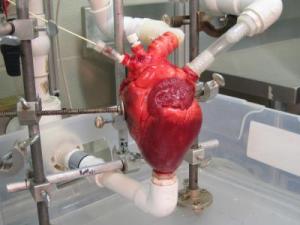Got an experiment in mind? Looking for a lab rat? Unless you’re trying out a new grilled cheese recipe, humans won’t be your first trial subjects. Dangerous experiments usually call for live animal testing before human subjects get involved. But why use live organs if you can just reanimate dead ones? Introducing Piglet, the organ donor.

Normally, testing out cardiac surgery ideas goes something like this: Let’s say Dr. Robotnik thought up a new technique for repairing heart valves. Before it hits the OR, the technique gets tried out on live pigs. Swine hearts are pretty similar to human hearts, making them the ideal (ahem) guinea pigs. But getting permission for live animal testing is time-consuming and expensive, costing around $2,500 a pop. Perfecting a technique might take a number of trials, which means a number of pigs, more time & money, then PETA gets involved… you get the idea. A real headache. So what’s a surgical innovator to do?
Fake it! A new machine at North Carolina State University takes a dead heart from your local butcher and makes it pump just like the real thing. This way, doctors can test out new tools and techniques for heart surgery without the time and money required for live trials. The machine pumps pressurized saline through the cardiac tissue, making it move in a sort of pig-heart version of Weekend at Bernie’s. All this is controlled by a computer, and even has live cameras to film the action from inside. Plus, the new technique is recession-proof at a cool $25 bucks per trial. Check out this video of the system in action:
Of course, most new tools and techniques still get a live pig trial before it’s all said and done, just to be sure. But the new system gives doctors an intermediate stage, which helps them be sure their surgical concepts are sound before they start operating on live pigs, and eventually live humans. That’ll save a few pigs from the operating table, save a few research dollars, and (hopfully) save a few human lives with the results.
Designed by engineering PhD student Andrew Richards, the project was funded by the NIH National Heart, Lung and Blood Institute. In their test study, the machine aimed to replicate a heart disease called mitral regurgitation, which is when blood leaks from the left ventricle into the left atrium (in case it’s been a while since your last bio class, that’s the wrong way). By simulating the disease with the machine, doctors can test out new ways to repair the disorder without the costs of live trials. The technique can be used to work out the kinks in all sorts of new heart repair operations.
This is different from the much-cooler living lung repair, which actually keeps human organs alive for repair during a transplant. Here, a dead pig heart gets to serve science before it goes… wherever it is dead pig hearts normally go. Recycling organs can make biomedical research just a wee bit more sustainable, and save a few pennies our enormously expensive health care system. Who says going green has to cost so much green? Waste not, want not!
So the next time you’re chowing down on a glazed ham, remember: your dinner’s heart might be pumping away in a lab somewhere. Hope that doesn’t ruin your appetite or anything.


